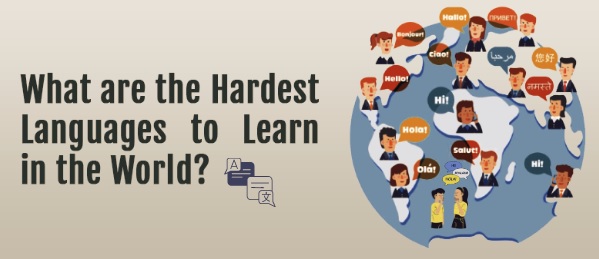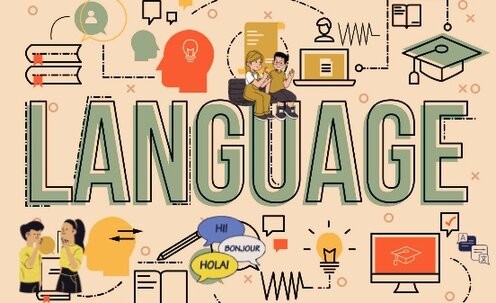It takes outstanding skill to learn one of the hardest languages in the world. The ability to speak many languages will offer you an advantage over the competitors. Understanding another language is essential if you want to comprehend other cultures, countries, and people. Acquiring a new language will expand your perspective. It is now required to acquire an additional language to succeed in the current globalized business environment.
Learning a new language is good practice for your brain. It is not only a useful talent but also a fantastic mental exercise. Our brain undergoes several intellectual processes when we seek to learn a new language. And these processes are significant to our brain’s overall health and performance.
Interesting facts regarding languages: Hardest languages to learn
| # Currently, there are over 7,099 languages spoken worldwide. # Papua, where there are close to 850 languages spoken, is likely the nation with the greatest number of languages and dialects. # In Bangladesh, on the 21st of February 1952, a group of people dedicates their life to saving their mother language. # February 21 was designated International Mother Language Day by UNESCO in 1999. # The Bible is the book that has been translated into most languages 2,454. # Among the first languages to be identified are Sanskrit, Sumerian, Hebrew, and Basque. # The world’s longest alphabet, used to write the Khmer language of Cambodia, contains 74 characters. # Chinese, English, French, Russian, Arabic, and Spanish these six languages are the official languages of the UN. # There are 23 languages spoken by half the world’s population. # Only the Basque language is unrelated to any other language in the world. # The country with the most official languages, with a total of 11, is South Africa. # More than 2300 languages are spoken throughout Asia. # With over 250,000 words, the English language has the most words. |

The world’s hardest languages to learn!
Here we will openly discuss the complex part of some languages,
Mandarin:
The most common language spoken worldwide is Mandarin. It has more than 1 billion native speakers. Mandarin language, also called Northern Chinese, Chinese (Pinyin) Guanhua (“Officials’ Language”), or (Wade-Giles romanization) Kuan-hua. The national language of China is Mandarin. And it is one of the UN’s six official languages. People in Taiwan, Singapore, Malaysia, and Indonesia also use Mandarin widely.
Mandarin uses a complex writing system consisting of thousands of characters. Mandarin is a tonal language featuring a neutral tone in addition to four different tones. For speakers of other languages, perfecting the correct pronunciation of tones can be challenging.
Others may find it challenging to learn how to correctly pronounce tones because a word’s meaning might vary just dependent on tone.
Arabic:
The official language of the 22 nations is Arabic. More than 300 million people speak Arabic globally. Middle East and North African people use the Arabic language.
The Arabic alphabet, called Al-abjadiyah, has 28 letters. It employs a distinctive script that reads and writes from the right to the left. In addition to extensive verb conjugation, noun declension, and the idea of grammatical gender, Arabic includes a complicated grammar structure. Here verbs frequently appear before the subject in grammar, and many nouns have dual forms in addition to the singular and plural.
Japanese:
The Japanese alphabet consists of 46 fundamental letters, and these 46 can be used to create new characters. Three different scripts—hiragana, katakana, and kanji—make up the writing system. The writing system, which uses tens of thousands of “kanji” characters, is the most difficult component of learning Japanese.
The verb must come after the other words in a phrase, according to strict word order rules. This is so because sentence components in Japanese are identified by grammatical particles.
Hungarian:
Hungarian is a Uralic language. Approximately 13 million individuals on Earth speak this language. Mostly Hungary, Romania, and Slovakian people are using this language.
The Latin alphabet is the foundation of the Hungarian alphabet. This alphabet has 26 letters in total. It is a distinctive and fascinating language distinguished by a large vocabulary and difficult syntax. Hungarian grammar presents a challenge to non-native speakers due to its vast conjugation patterns and varied vowel harmony scheme.
Korean:
Approximately 78 million people globally speak the Korean language. This is the official language of both Korea. The Korean language has an alphabet called Hangul. Which was created in the 15th century. There are only 24 symbols in the Korean alphabet. The alphabet is relatively easy to learn. But Korean grammar is complex. Verb endings, honorifics, and sentence structure play a significant role in communication.
Russian:
The language of Russia is East Slavic. It is mostly spoken in Russia, Belarus, Ukraine, and other former Soviet Union countries by more than 260 million people globally.
Due to its complex pronunciation, Russian can be challenging for speakers of other languages. Russian nowadays has 33 letters. The Cyrillic alphabet is used in Russian, which could initially be difficult for non-native speakers. Russia has a very sophisticated case system, verb aspect system, and gender agreement. As a result of noun declensions and adjective ends changing according to grammatical cases, sentence structure and word forms become more intricate.

You can use technology to learn the hardest languages:
At present a fantastic resource for learning a new language is technology. There are numerous internet resources and software solutions available to aid in language learning. It consists of mobile apps, interactive online communities, online courses, and software for learning languages. With convenient access to the content at any time and from any location, these systems offer a practical and flexible approach to learning a new language. Some of the popular technologies are Duolingo, Rosetta Stone, Babbel, Memrise, Busuu, FluentU, etc.
Ultimately, learning a language presents a unique set of difficulties. But some languages are well known for being exceptionally challenging to pick up. These languages are challenging to learn because of things like strange writing systems, challenging grammar structures, distinctive sounds, and cultural quirks. Despite these challenges, anyone can eventually surmount them and become fluent in a new language with constant practice, effort, and exposure to it.
